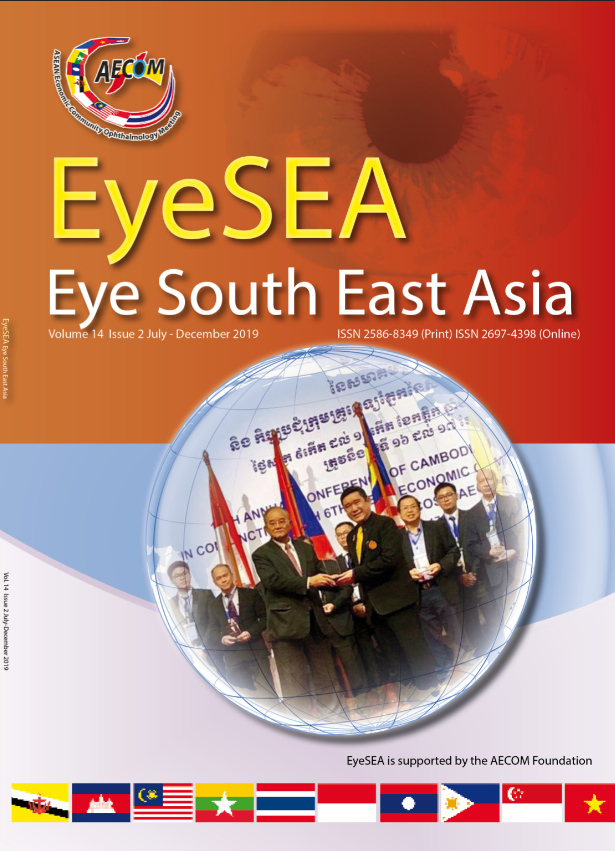Comparison of Intraocular lens power calculation formulas in primary angle closure glaucoma
Main Article Content
Abstract
Objective: To compare the accuracy of the 4 intraocular lens (IOL) power calculation formulas in primary angle closure glaucoma (PACG) eyes. All the formulations in this study are common and widely use; SRK/T, Hoffer Q, Holladay I and Haigis.
Design: Retrospective chart review /retrospective cohort study
Methods: Data collection was performed through the OPD cards of the PACG patients who already pass uneventful cataract surgery with monofocal IOL by Dr. Anuwat Prutthipongsit. All the patients had Pre-operative data collection of Axial length (AL), Anterior Chamber Depth (ACD), Keratometry, and Predicted refractive outcomes using SRK/T, Hoffer Q, Holladay I and Haigis by IOL master (Carl Zeiss). Post-operative data was also collected. Analysis of the accuracy of all formulas was done by comparison of the predicted refractive outcomes and the measured refractive outcomes using the mean error (ME) and mean error square (MES)
Conclusion: The Hoffer Q formula produced the lowest ME (0.009+-0.54 D.), but not the MES (0.303 D.), Whilst the most accuracy formula with the least random error (MES=0.216 D.) is SRK/T with also low ME (0.083+-0.45 D.). The Haigis formula produced the highest MES (0.323 D.) this inaccuracy of the Haigis formula may be caused by biometric data (using ACD). However, There is no statistical significant in different between all this 4 formulas (According to the small sample size). AL is the most weighted variable with significant effect to the predicted refractive error (P=0.029). All four formulas have positive ME representing Hyperopic result than intend.
Article Details
References
2.Hayashi K, Hayashi H, Nakao F, Hayashi F. Changes in anterior chamber angle width and depth after intraocular lens implantation in eyes with glaucoma. Ophthalmology. 2000;107:698–703.
3.Francis BA, Wang M, Lei H, et al. Changes in axial length following trabeculectomy and glaucoma drainage device surgery. Br J Ophthalmol. 2005;89:17–20.
4.Nonaka A, Kondo T, Kikuchi M, et al. Angle widening and alteration of ciliary process configuration after cataract surgery for primary angle closure. Ophthalmology. 2006;113:437–441.
5.Narvaez J, Zimmerman G, Stulting RD, Chang DH. Accuracy of intraocular lens power prediction using the Hoffer Q, Holladay 1, Holladay 2, and SRK/T formulas. J Cataract Refract Surg. 2006;32:2050–2053.
6.Kang SY, Hong S, Won JB, et al. Inaccuracy of intraocular lens power prediction for cataract surgery in angle-closure glaucoma. Yonsei Med J. 2009;50:206–210.
7.Aristodemou P, Knox Cartwright NE, Sparrow JM, Johnston RL. Formula choice: Hoffer Q, Holladay 1, or SRK/T, and refractive outcomes in 8108 eyes after cataract surgery with biometry by partial coherence interferometry. J Cataract Refract Surg. 2011;37(1):63–71.
8.Jongsoo Joo, Woong-Ju Whang, Tae-Hoon Oh, Kyu-Dong Kang, Hyun-Seung Kim, Jung-Il Moon: Accuracy of Intraocular Lens Power Calculation Formulas in Primary Angle ClosureGlaucoma Korean J Ophthalmol. 2011 Dec; 25(6): 375–379.
9.SrivannaboonS, ChirapapaisanC, ChirapapaisanN, LertsuwanrojB, ChongchareonM. : Accuracy of Holladay 2 formula using IOLMaster parameters in the absence of lens thickness value. Graefes Arch Clin Exp Ophthalmol. 2013 Nov;251(11):2563-7.
10.Marilita M. Moschos, Irini P Chatziralli, Chryssanthi Koutsandrea: Intraocular lens power calculation in eyes with short axial length Indian J Ophthalmol. 2014 Jun; 62(6): 692–694


